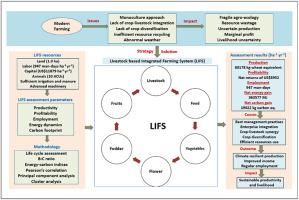Livelihood and energy-carbon dynamics of livestock-based integrated farming system: Assessment and implications for sustainable farming
IF 8.4
引用次数: 0
Abstract
Challenges of climate-resilient agricultural production, along with environmental sustainability, guided the study on livestock-based integrated farming systems (LIFS) to explore their merits and implications for sustainable farming. Consequently, a 3-year life cycle assessment of a 3-ha LIFS with 30 adult cattle units and diversified components (45 % food crops, 33.8 % fodder, 17.5 % vegetables, 2.5 % flowers, 1.3 % fruits, and allied activities) was conducted to evaluate among its components and against the traditional groundnut-wheat cropping system (GWCS). The study assessed ecosystem services, including resource recycling, productivity, profitability, employment, and energy-carbon dynamics involving the life cycle assessment approach. Findings reveal that LIFS yielded 80,178 kg wheat equivalent ha−1 yr−1, US$8952 net returns, 4,55,368 MJ energy output, and 33,974 kg carbon output from inputs of 90,791 MJ energy and GHG emissions equivalent to 14,942 kg carbon. Compared to GWCS, LIFS achieved 8.4× higher productions, 6.4× greater returns, 6.6× more employment, 3.0× higher energy productivity, and 4.6× greater net carbon gain due to crop–livestock synergy with improved management. Among components, livestock dominated inputs (86 % cost, 66 % energy, 92 % carbon) and outputs (77 % production, 66 % returns, 59 % employment), thus playing a crucial role in production and environmental sustainability. However, horticultural crops showed higher unit productivity and returns. The carbon footprint of LIFS (0.69 kg CO2 eq.) was higher than GWCS but better than similar livestock + crop systems. Conclusively, LIFS enhances climate resilience and ecosystem services; however, optimizing livestock's energy-carbon use can further impart greater environmental sustainability, offering valuable insights for researchers and policymakers to focus on immediate adoption of LIFS for stable livelihood, along with setting the long-term goal for sustaining the energy-carbon use to evolve a ‘total sustainability’ of production systems in study region as well as similar agroecology worldwide.

以牲畜为基础的综合农业系统的生计和能源-碳动态:评估及其对可持续农业的影响
气候适应型农业生产的挑战以及环境可持续性指导了以牲畜为基础的综合农业系统(LIFS)研究,以探索其优点和对可持续农业的影响。因此,对30头成年牛组成的3公顷LIFS进行了3年生命周期评估,并对其组成部分(45%的粮食作物,33.8%的饲料,17.5%的蔬菜,2.5%的花卉,1.3%的水果和相关活动)进行了评估,并与传统的花生-小麦种植系统(GWCS)进行了比较。该研究评估了生态系统服务,包括资源循环、生产力、盈利能力、就业和使用生命周期评估方法的能源-碳动态。研究结果表明,LIFS产生80,178公斤小麦当量(公顷- 1年- 1年),净收益8952美元,输出4,55,368兆焦耳能量,输入90,791兆焦耳能量,输出33,974公斤碳,温室气体排放相当于14,942公斤碳。与GWCS相比,LIFS的产量提高了8.4倍,回报提高了6.4倍,就业增加了6.6倍,能源生产率提高了3.0倍,由于作物与牲畜的协同作用和管理的改善,净碳收益提高了4.6倍。在各组成部分中,畜牧业在投入(86%的成本、66%的能源、92%的碳)和产出(77%的产量、66%的回报、59%的就业)中占主导地位,因此在生产和环境可持续性方面发挥着至关重要的作用。然而,园艺作物表现出更高的单位生产力和回报。LIFS系统的碳足迹(0.69 kg CO2当量)高于GWCS系统,但优于同类的牲畜+作物系统。最后,LIFS增强了气候适应能力和生态系统服务;然而,优化牲畜的能源-碳利用可以进一步赋予环境更大的可持续性,为研究人员和政策制定者提供有价值的见解,使他们能够专注于立即采用LIFS来稳定生计,同时设定维持能源-碳利用的长期目标,从而在研究区域以及全球类似的农业生态中发展出生产系统的“全面可持续性”。
本文章由计算机程序翻译,如有差异,请以英文原文为准。
求助全文
约1分钟内获得全文
求助全文

 求助内容:
求助内容: 应助结果提醒方式:
应助结果提醒方式:


